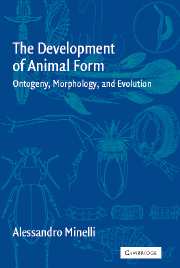Book contents
- Frontmatter
- Contents
- Preface
- Acknowledgements
- 1 The Nature of Development
- 2 Everything Begun to the Service of Development: Cellular Darwinism and the Origin of Animal Form
- 3 Development: Generic to Genetic
- 4 Periodisation
- 5 Body Regions: Their Boundaries and Complexity
- 6 Differentiation and Patterning
- 7 Size Factors
- 8 Axes and Symmetries
- 9 Segments
- 10 Evo-devo Perspectives on Homology
- Summary and Conclusions
- References
- Index
2 - Everything Begun to the Service of Development: Cellular Darwinism and the Origin of Animal Form
Published online by Cambridge University Press: 10 August 2009
- Frontmatter
- Contents
- Preface
- Acknowledgements
- 1 The Nature of Development
- 2 Everything Begun to the Service of Development: Cellular Darwinism and the Origin of Animal Form
- 3 Development: Generic to Genetic
- 4 Periodisation
- 5 Body Regions: Their Boundaries and Complexity
- 6 Differentiation and Patterning
- 7 Size Factors
- 8 Axes and Symmetries
- 9 Segments
- 10 Evo-devo Perspectives on Homology
- Summary and Conclusions
- References
- Index
Summary
Recent progress in developmental genetics [..] has given us remarkable insights into the molecular mechanisms of morphogenesis but has at the same time blurred the clear divide between structure and function. At the genetic or molecular level, it is difficult to tell where one ends and the other begins. One scientist's ‘cause’ is another scientist's ‘phenotype.’
S.F. Gilbert and J.A. Bolker 2001: 1Without its robust calcified exoskeleton, a crab would be very vulnerable prey. Its pincers would be harmless; its whole locomotory apparatus would be at loss. The same applies to a mammal, or a bird, without its internal skeleton. If the adult is to be endowed with a complete, functional skeleton, the business of constructing one must start early in development. But how and why were skeletons invented?
If an explanation of what happens in development is to be searched for in development itself, as argued in chapter 1, then the reasons for the first appearance of a skeleton must be sought for in development rather than in mechanics. I am not speaking of the heavy armour of an adult crab nor the sophisticated architecture of a vertebra. I am speaking, instead, of the reasons why some early multicellular organisms found it profitable to produce a cuticle, or to adventure into the previously unexplored paths of biomineralisation. To place this question in a plausible context, we need to digress some.
- Type
- Chapter
- Information
- The Development of Animal FormOntogeny, Morphology, and Evolution, pp. 12 - 20Publisher: Cambridge University PressPrint publication year: 2003



